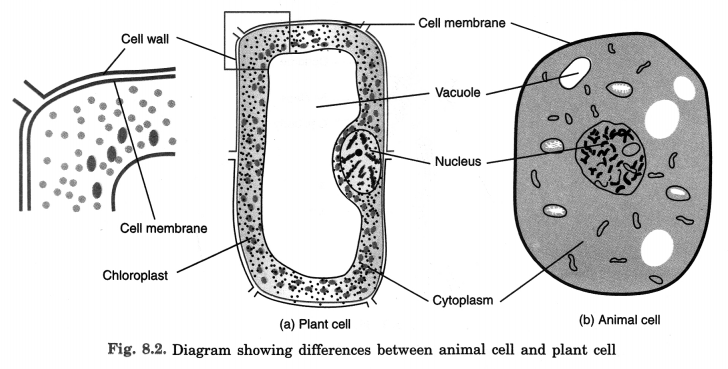Cell Structure and Functions
Question 1.
Indicate whether the following statements are True (T) or False (F):
- (a) Unicellular organisms have a one-celled body. (T/F)
- (b) Muscle cells are branched. (T/F)
- (c) The basic living unit of an organism is an organ. (T/F)
- (d) Amoeba has an irregular shape. (T/F)
Answer.
- (a) True
- (b) True
- (c) False
- (d) True.
Question 2.
Make a sketch of the human nerve cell. What function do nerve cells
perform?
Answer.

The nerve cell receives and transfers messages, thereby helping to control and coordinate the working of different parts of the body.
Question 3.
Write short notes on the following:
- Cytoplasm
- Nucleus of a cell.
Answer.
- It is the jelly-like substance found between the nucleus and the cell membrane. It contains the nucleus and many small structures called organelles. Cytoplasm, along with nucleoplasm, forms the living substance of the cell, called the protoplasm.
- It is an important component of the living cell. It is generally spherical and located in the center of the cell. The Nucleus is separated from the cytoplasm by a membrane called the nuclear membrane. The liquid substance of the nucleus is termed nucleoplasm. There is a smaller spherical body in the nucleus which is called the nucleolus. The Nucleus also contains thread-like structures called chromosomes. These carry genes and help in inheritance. The Nucleus acts as the control center of the activities of the cell.
With a microscope of higher magnification, we can see a smaller spherical, dense body in the nucleus. It is called the nucleolus. In addition, the nucleus contains thread-like structures called chromosomes. These carry genes and help in the inheritance or transfer of characters from the parents to the next generation. The chromosomes can be seen only when the cell divides. The nucleus, in addition to its role in inheritance, acts as the control centre of the activities of the cell.
Question 4.
Which part of the cell contains organelles?
Answer.
The Cytoplasm contains organelles of the cell.
Question 5.
Make sketches of animal and plant cells. State three differences between them.
Answer.
| Plant cells |
Animal cells |
|
1. The outermost covering is cell wall which is made of cellulose.
2. Plastids (e.g., chloroplasts) are present.
3. Large vacuoles are present.
|
1. The outermost covering is the plasma membrane which is living material.
2. Plastids are absent.
3. No or small vacuoles Eire present.
|

Question 6.
State the difference between eukaryotes and prokaryotes.
Answer.
| Eukaryotes |
Prokaryotes |
| 1. Nucleus of the cell has a nuclear membrane. |
1. Nucleus is not bounded by a membrane. |
| 2. Possess membrane-bound organelles. |
2. Membrane-bound organelles are absent. |
| 3. Examples include all higher plants and animals. |
3. Examples are bacteria and blue-green algae. |
Question 7.
Where are chromosomes found in a cell? State their functions.
Answer.
Chromosomes are found in the nucleus of the cell. They carry genes and help in inheritance i.e., transfer of characters from the parents to the offspring.
Question 8.
Cells are the basic structural units of living organisms. Explain.
Answer.
All organisms are made up of cells. They have different designs, shapes and sizes in the living organism. All the life processes take place inside a cell. Many similar cells aggregate together to make tissue. So many tissues are organised to form organs and finally, many organs are organised to form a system. So we can say that cells are the basic units of living organisms.
Question 9.
Explain why chloroplasts are found only in plant cells?
Answer.
Chloroplasts contain chlorophyll which synthesizes food in plants by the process of photosynthesis. As photosynthesis does not occur in animals, it does not contain chloroplasts.
Question 10.
Complete the crossword with the help of clues given below:
Across
-
1.This is necessary for photosynthesis.
-
3.Term for component present in the cytoplasm.
-
6.The living substance in the cell.
-
8.Units of inheritance present on the chromosomes.
Down
-
1.Green plastids.
-
2.Formed by a collection of tissues.
-
4.It separates the contents of the cell from the surrounding medium.
-
5.Empty structure in the cytoplasm.
-
7.A group of cells.
Answer.
